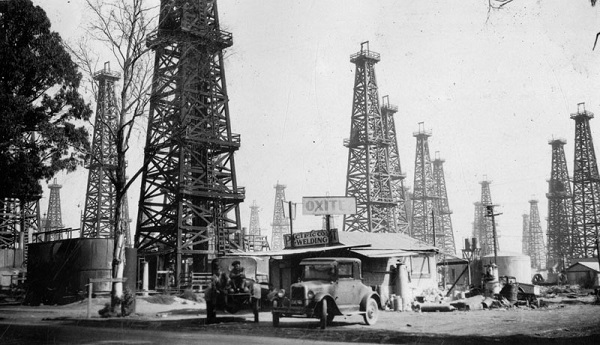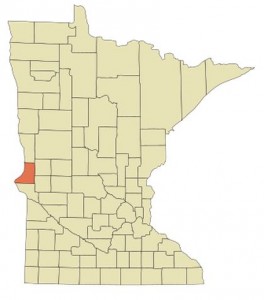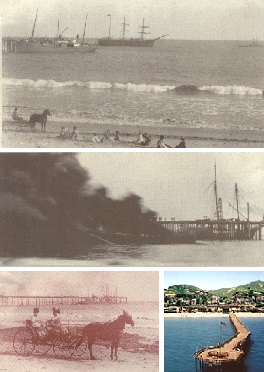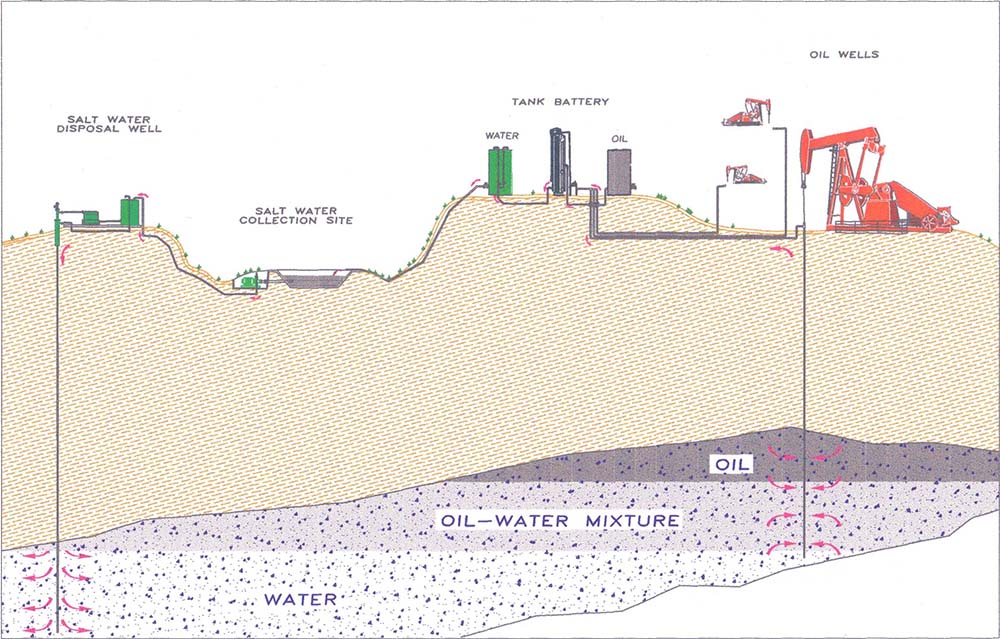by Bruce Wells | Jun 23, 2025 | This Week in Petroleum History
June 23, 1921 – Signal Hill brings California Oil Boom –
Another southern California drilling boom began when a geyser of “black gold” erupted 114 feet high at Signal Hill. The Alamitos No. 1 well, which revealed a giant oilfield, produced about 600 barrels of oil a day when it was completed.

The Signal Hill oil discovery helped make California the source of one-quarter of the world’s oil output. “Porcupine Hill” and the Long Beach field produced 260,000 barrels of oil a day by 1923. Photo courtesy of Los Angeles Museum of Natural History.
Soon known as “Porcupine Hill,” the Signal Hill oilfield 20 miles south of Los Angeles produced almost 260,000 barrels of oil a day by 1923. Combined with the 1892 Los Angeles Oilfield discovery and the 1920 Huntington Beach oilfield, California produced one-fourth of the world’s oil. A monument dedicated in 1952 at Signal Hill’s Discovery Well Park has served “as a tribute to the petroleum pioneers for their success here.”
Learn more in Signal Hill Oil Boom.
June 23, 1947 – Supreme Court limits State Rights to Continental Shelf
The U.S. Supreme Court ruled California could not claim rights to the continental shelf beyond three nautical miles. Litigation resulted from President Harry Truman’s September 1945 Continental Shelf Proclamation, which placed control with the federal government. The Supreme Court ruling on the Truman Proclamation affirmed federal jurisdiction “with respect to the natural resources of the subsoil and seabed of the continental shelf.” Similar rulings affecting Louisiana and Texas would be made in 1950.
June 24, 1937 – Traces of Oil found in Minnesota
In far western Minnesota, a remote wildcat well drilled in Traverse County began producing three barrels of oil a day from a depth of 864 feet. The unlikely discovery prompted more leasing, but no commercial quantities of oil.

Traverse County, Minnesota, where oil production peaked in 1937.
The lack of an oilfield reaffirmed geologists’ conclusions since 1889 that conditions for significant petroleum deposits did not exist in Minnesota, despite some water wells in southern Minnesota containing small amounts of natural gas.
“Not much oil and gas is obtained from Precambrian rocks, with which Minnesota is very amply blessed,” noted the 1984 book Minnesota’s Geology.
June 25, 1889 – First Oil Tanker catches Fire in California
The first oil tanker built for that purpose, a schooner named W.L. Hardison, burned at its wharf in Ventura, California. The Hardison & Stewart Oil Company (later Union Oil) commissioned the experimental vessel, which offered an alternative to paying for railroad oil tank cars charging one dollar per oil barrel to reach markets in San Francisco.
With oil-fired steam boilers and supplemental sails, the schooner could ship up to 6,500 barrels of oil below deck in specially constructed steel tanks. After the fire, the tanks were recovered and used at the company’s Santa Paula refinery. It took 11 years before the company launched a replacement tanker, the Santa Paula.

Rare photographs of the doomed oil tanker W.L. Hardison and Ventura pier courtesy the Museum of Ventura County.
The Ventura Wharf Company by April 1898 had exported 518,204 barrels of bulk oil during the previous year, according to the Los Angeles Times. The pier remained a working wharf until 1936 when it became the longest recreational wooden pier in California.
Designated a Ventura Historic Landmark in 1976 and now 1,600 feet long, California’s oldest pier was refurbished for $2.2 million in 2000, according to the Museum of Ventura County, which also operates archaeological and agricultural museums. In nearby Santa Paula, the 1890 headquarters building of Union Oil Company is home to the California Oil Museum.
June 25, 1901 – Red Fork Discovery leads to Tulsa Boom
Six years before statehood, Oklahoma witnessed a second oil discovery (some say the third — see Another First Oklahoma Oil Well) when two drillers from the Pennsylvania oil regions discovered an oilfield at Red Fork in the Creek Indian Nation.
John Wick and Jesse Heydrick drilled the Sue A. Bland No. 1 well near the Creek village across the Arkansas River from Tulsa. Sue Bland, a Creek citizen, was the wife of homesteader Dr. John C. W. Bland. Their Red Fork well produced just 10 barrels of oil a day from a depth of 550 feet, but created a drilling boom attracting petroleum companies to nearby Tulsa.
Learn more in Red Fork Gusher.

June 25, 1999 – Texas Post Office named Historic Place
The former U.S. Post Office building in Graham, Texas, with its Great Depression-era oilfield mural by Alexandre Hogue, joined the National Register of Historic Places. Hogue’s 1939 “Oil Fields of Graham” has been joined by other art exhibits in its historic Art Deco building on Third Street.

“Oil Fields of Graham” by Alexandre Hogue, a 1939 mural in the Old Post Office Museum & Art Center of Graham, Texas. The white-haired gentleman was the mayor of Graham.
Hogue’s artwork included many southwestern scenes as part of the New Deal Federal Arts Program. His murals on the walls of public buildings often portrayed scenes of the Texas petroleum industry. In Graham’s historic building on Third Street, “Oil Fields of Graham,” 12 feet wide and 7 feet high, is among exhibits at the Old Post Office Museum & Art Center, which opened in 2002.
Learn more in Oil Art of Graham, Texas.
June 26, 1885 – Natural Gas Utility established in Pennsylvania
Peoples Natural Gas Company incorporated — the first Pennsylvania natural gas company chartered by the state to regulate production, transmission, and distribution of natural gas. A similar utility incorporation had taken place a year earlier in New York City when six competing companies combined to form Consolidated Edison.
By 1891, the Pittsburgh-based limited liability company had consolidated pipelines and facilities of Pittsburgh Natural Gas, Lawrence Natural Gas, Conemaugh Gas, and Columbia Natural Gas companies. More than a dozen more companies would be acquired between 1903 and 1961. The large utility added Saxonburg Heat and Light in 1979 and Equitable Gas in 2017, expanding natural gas services in West Virginia and Kentucky.
June 28, 1887 – Kansans celebrate First Natural Gas Jubilee
After erecting flambeau arches at the four corners of the town square, Paola, Kansas, hosted what local leaders described as “the first natural gas celebration ever held in the West.” Excursion trains from Kansas City brought about 2,000 people, “to witness the wonders of natural gas,” according to the Miami County Historical Museum, which preserves the region’s petroleum history.

Paola’s giant natural gas field attracted more petroleum exploration to Miami County, including this circa 1920 oil well. Photo courtesy Kansas Historical Society.
The town’s special event included a “grand illumination” of natural gas street lights, where “gas was attached to a yard sprinkler by a rubber hose, and when it was ignited there appeared nests of small blazes which were beautiful and attractive.”
Learn more in First Kansas Oil Well.

June 28, 1967 – Hall of Petroleum opens in Smithsonian Museum
The Hall of Petroleum opened at the Smithsonian Institution’s Museum of History and Technology in Washington, D.C. Exhibits included cable-tool and rotary rig drilling technologies and counterbalanced pumping units, The Hall of Petroleum also featured 1967 developments in offshore exploration and production.
Visitors to what in 1980 became the National Museum of American History were greeted by a mural painted by Delbert Jackson of Tulsa, Oklahoma. Jackson spent two years creating his 13-foot by 56-foot painting with scenes of oil and natural gas exploration, production, refining, and transportation.

A “Panorama of Petroleum” once greeted visitors to the Smithsonian’s American History Museum in Washington, D.C. The 13-foot by 56-foot mural today is exhibited inside Tulsa International Airport.
Jackson’s “Panorama of Petroleum” featured industry pioneers and served as a visual map to the hall’s oilfield technology exhibits. “If the hall can increase the public’s knowledge of and respect for the technical skill and know-how of those who make this energy available, it will have served its purpose,” noted the exhibit’s 1967 catalog. The mural ended up in storage for three decades, until finding a home at Tulsa International Airport.
Learn more in Smithsonian’s “Hall of Petroleum.“

June 29, 1956 – Interstate Highway System enacted
The Federal-Aid Highway Act of 1956, popularly known as the National Interstate and Defense Highways Act, became law. Passed at the urging of President Dwight D. Eisenhower, the act provided 90 percent federal funding for a “system of interstate and defense highways,” and authorized spending $25 billion through 1969 for construction of about 41,000 miles of interstates.

The interstate system reached 48,191 miles in 2016. Federal regulations banned collecting tolls but that would change.
“Of all his domestic programs, Eisenhower’s favorite by far was the Interstate System,” noted historian Stephen Ambrose. The thirty-fourth president urged passage of the act for national defense; interstates would be needed for evacuating major cities during a nuclear war.
_______________________
Recommended Reading: Signal Hill, California, Images of America (2006); Minnesota’s Geology (1982) Tulsa Oil Capital of the World, Images of America
(2006); Minnesota’s Geology (1982) Tulsa Oil Capital of the World, Images of America (2004); Oil in West Texas and New Mexico
(2004); Oil in West Texas and New Mexico (1982); Minnesota’s Geology (1982); Black Gold in California: The Story of California Petroleum Industry
(1982); Minnesota’s Geology (1982); Black Gold in California: The Story of California Petroleum Industry  (2016); Early California Oil: A Photographic History, 1865-1940
(2016); Early California Oil: A Photographic History, 1865-1940 (1985); Tulsa Oil Capital of the World, Images of America
(1985); Tulsa Oil Capital of the World, Images of America (2004); Oil in West Texas and New Mexico
(2004); Oil in West Texas and New Mexico (1982); Official Guide to the Smithsonian
(1982); Official Guide to the Smithsonian (2016); Eisenhower: Soldier and President
(2016); Eisenhower: Soldier and President (1968). Your Amazon purchase benefits the American Oil & Gas Historical Society. As an Amazon Associate, AOGHS earns a commission from qualifying purchases.
(1968). Your Amazon purchase benefits the American Oil & Gas Historical Society. As an Amazon Associate, AOGHS earns a commission from qualifying purchases.
_______________________
The American Oil & Gas Historical Society (AOGHS) preserves U.S. petroleum history. Please become an AOGHS annual supporter and help maintain this energy education website and expand historical research. For more information, contact bawells@aoghs.org. © 2025 Bruce A. Wells. All rights reserved.
by Bruce Wells | Sep 30, 2024 | This Week in Petroleum History
September 30, 2006 – Roughnecks Statue dedicated at Signal Hill –
A bronze “Tribute to the Roughnecks” statue was dedicated near the Alamitos No. 1 well, which in 1921 revealed California’s prolific Long Beach oilfield 20 miles south of Los Angeles.

Signal Hill once had so many derricks people called it Porcupine Hill. The city of Long Beach is visible in the distance from the “Tribute to the Roughnecks” statue by Cindy Jackson.
The statue by Cindy Jackson has since commemorated the Signal Hill Oil Boom, serving as “a tribute to the petroleum pioneers for their success here, a success which has, by aiding in the growth and expansion of the petroleum industry, contributed so much to the welfare of mankind.”

October 1, 1908 – Ford Motor Company produces First Model T
The first production Ford Model T rolled off the assembly line in Detroit. Between 1908 and 1927, Ford built about 15 million more, each fueled by inexpensive gasoline. The popularity of the Model T was timely for the U.S. petroleum industry, which faced falling demand for kerosene as consumers switched to electric lighting.

Ford Model T tires were white until 1910, when the petroleum product carbon black was added to improve durability.
New major oilfield discoveries, especially the 1901 “Lucas Gusher” at Spindletop Hill near Beaumont, Texas, helped meet growing demand for what had been a refining byproduct, gasoline.
October 1, 1942 – Water Injection begins in East Texas
The East Texas Salt Water Disposal Company drilled the first saltwater injection well in the 12-year-old East Texas oilfield near the towns of Tyler, Longview, and Kilgore. As early as 1929, the Federal Bureau of Mines had determined injecting recovered saltwater into formations could increase reservoir pressures and oil production.

Saltwater injection wells have improved oil production. By disposing produced water at a low cost, marginal East Texas wells have remained viable. Illustration courtesy East Texas Salt Water Disposal Company.
The Texas Railroad Commission established the saltwater disposal company as a public utility to operate in the oilfield. The company treated and re-injected about 1.5 billion barrels of saltwater in its first 13 years, prompting the commission to proclaim saltwater injection as the “greatest oil conservation project in history.”
October 2, 1919 – Future “Mr. Tulsa” incorporates Skelly Oil
Skelly Oil Company incorporated in Tulsa, Oklahoma, with founder William Grove Skelly as president. He had been born in 1878 in Erie, Pennsylvania, where his father hauled oilfield equipment in a horse-drawn wagon.

Born near Pennsylvania’s early oilfields, independent oilman William Skelly’s company helped make Tulsa the “Oil Capital of the World.”
Skelly’s success in the El Dorado oilfield east of Wichita, Kansas, helped him launch Skelly Oil and other ventures, including Midland Refining Company, which he founded in 1917. As Tulsa promoted itself as “Oil Capital of the World,” Skelly became known as “Mr. Tulsa.”
Skelly served as president of Tulsa’s famous International Petroleum Exposition for 32 years until his death in 1957.

October 3, 1930 – East Texas Oilfield discovered on Widow’s Farm
With a crowd of more than 4,000 expectant landowners, leaseholders, creditors, and others watching, the Daisy Bradford No. 3 wildcat well was successfully shot with nitroglycerin near Kilgore, Texas.

Spectators gathered on the widow Daisy Bradford’s farm near Kilgore, Texas, to watch the October 3, 1930, “shooting” of the discovery well of what proved to be the largest oilfield in the lower 48 states. Photo courtesy Jack Elder, The Glory Days.
“All of East Texas waited expectantly while Columbus ‘Dad’ Joiner inched his way toward oil,” explained historian Jack Elder in 1986. “Thousands crowded their way to the site of Daisy Bradford No. 3, hoping to be there when and if oil gushed from the well to wash away the misery of the Great Depression.”
Geologists were stunned when it became apparent the remote wildcat well on the widow Daisy Bradford’s farm — along with two other wells far to the north — were part of the same oil-producing formation (the Woodbine) that encompassed more than 140,000 acres. The “Black Giant” would produce billions of barrels of oil in coming decades.
Learn more in East Texas Oilfield Discovery.
October 3, 1980 – Museum opens in East Texas Oilfield
Fifty years after the discovery of the East Texas oilfield, the East Texas Oil Museum at Kilgore College opened as “a tribute to the independent oil producers and wildcatters, the men and women who dared to dream as they pursued the fruits of free enterprise.”

The East Texas Oil Museum since 1980 has hosted events and maintained exhibits preserving the “Black Giant” oilfield discovered during the Great Depression. Photos by Bruce Wells.
Established with funding from the Hunt Oil Company, the museum at Kilgore College recreated a 1930s boom town atmosphere.

October 4, 1866 – Oil Fever spreads to Allegheny River Valley
Just 15 miles east of Titusville, Pennsylvania, site of the first U.S. oil well, an oilfield discovery at Triumph Hill sparked another wild rush of speculators and new drilling. America’s petroleum industry was barely seven years old when wooden cable-tool derricks and engine houses replaced hemlock trees along the Allegheny River.
Learn more about post-Civil War oil boom towns in Derricks of Triumph Hill.
October 4, 1901 – Drake Memorial dedicated in Pennsylvania
More than 2,500 people, including his widow, Laura Dowd Drake, attended the unveiling of a monument to the “father of the petroleum industry,” Edwin L. Drake, who had died in relative obscurity 1880. Standard Oil Company executive Henry Rogers commissioned the marble, semi-circle memorial in Titusville, Pennsylvania.

Unveiling of Drake Monument, Titusville, PA. Oct. 4th 1901. Thousands attended the dedication in Woodlawn Cemetery. Photo by John Mather courtesy Drake Well Museum.
The monument, which includes a bronze statue by Charles Henry Niehaus, was dedicated in Woodlawn Cemetery. Learn more by visiting Titusville’s Drake Well Museum and Park.

October 5, 1915 – Science of Petroleum Geology reveals Oilfield
Using the new earth science of petroleum geology for finding oil led to discovery of the giant Mid-Continent field in central Kansas. Drilled by Wichita Natural Gas Company, a subsidiary of Cities Service Company, the well revealed the 34-square-mile El Dorado oilfield.

The Stapleton No. 1 well discovered the El Dorado, Kansas, oilfield, which became one of the largest producing fields in the world. By 1919, Butler County had more than 1,800 producing oil wells. Photo by Bruce Wells.
“Pioneers named El Dorado, Kansas, in 1857 for the beauty of the site and the promise of future riches but not until 58 years later was black rather than mythical yellow gold discovered when the Stapleton No. 1 oil well came in on October 5, 1915,” explained geologist Lawrence Skelton in 1997.
The Stapleton No. 1 well east of Wichita initially found oil at a depth of 600 feet before being deepened to 2,500 feet to produce 110 barrels of oil a day from the Wilcox sands. Natural gas discoveries one year earlier at nearby Augusta had prompted El Dorado civic leaders to seek their own geological study.

The Stapleton No. 1 well and the Kansas Oil Museum preserve a 1915 oil discovery. Photo by Bruce Wells.
The Kansas Oil Museum preserves the state’s petroleum heritage with historic oilfield equipment displayed on 10 acres east of the city. Museum exhibits describe how lessons from the El Dorado field helped launch petroleum geology as a profession while establishing El Dorado as a center for refining.
Learn more in the Kansas Oil Boom.
October 5, 1958 – Water Park opens in West Texas for a Day
A water park inside a Depression-Era experimental concrete oil tank opened to public in West Texas. The day’s festivities at Monahans attracted swimmers, boaters, anglers, and even water skiers to the massive, manmade lake — before leaks at the seams forced it to close the next day.

The Million Barrel Museum’s site was originally built to store Permian Basin oil. For scale, note the railroad car and caboose exhibit at upper right.
A local couple had attempted to find a good use for the 525-foot by 422-foot “million barrel reservoir” once covered by a redwood dome roof. The concrete tank had been completed in 1928 by Shell Oil due to a lack of pipelines for Permian Basin oil. Shell stopped using the tank because of the company could not prevent oil from leaking at the seams.
Learn more in Million Barrel Museum.

October 6, 1886 – Natural Gas fuels Glass Manufacturing
A 900-foot-deep natural gas well in a cornfield near Kokomo, Indiana, helped establish the Indiana Natural Gas Company and the Opalescent Glass Works, now Kokomo Opalescent Glass, which has been in continuous operation since 1888.
Although the glass company almost went bankrupt when natural gas supplies dwindled, it recovered and in 1893 sold thousands of pounds of stained glass to Tiffany Glass Company and electric insulators to Edison General Electric. Indiana’s first natural gas well had been drilled in 1867 seeking oil (see Indiana Natural Gas Boom).
_______________________
Recommended Reading: Signal Hill, California – Images of America (2006); From Here to Obscurity: An Illustrated History of the Model T Ford, 1909 – 1927
(2006); From Here to Obscurity: An Illustrated History of the Model T Ford, 1909 – 1927 (1971); Artificial Lift-down Hole Pumping Systems
(1971); Artificial Lift-down Hole Pumping Systems (1984); An adventure called Skelly: A history of Skelly Oil Company through fifty years, 1919-1969 (1970); The Black Giant: A History of the East Texas Oil Field and Oil Industry Skullduggery & Trivia
(1984); An adventure called Skelly: A history of Skelly Oil Company through fifty years, 1919-1969 (1970); The Black Giant: A History of the East Texas Oil Field and Oil Industry Skullduggery & Trivia (2003); Early Texas Oil: A Photographic History, 1866-1936
(2003); Early Texas Oil: A Photographic History, 1866-1936 (2000); Western Pennsylvania’s Oil Heritage
(2000); Western Pennsylvania’s Oil Heritage (2008); The fire in the rock: A history of the oil and gas industry in Kansas, 1855-1976
(2008); The fire in the rock: A history of the oil and gas industry in Kansas, 1855-1976 (1976); Chronicles of an Oil Boom: Unlocking the Permian Basin
(1976); Chronicles of an Oil Boom: Unlocking the Permian Basin (2014). Your Amazon purchase benefits the American Oil & Gas Historical Society. As an Amazon Associate, AOGHS earns a commission from qualifying purchases.
(2014). Your Amazon purchase benefits the American Oil & Gas Historical Society. As an Amazon Associate, AOGHS earns a commission from qualifying purchases.
_______________________
The American Oil & Gas Historical Society (AOGHS) preserves U.S. petroleum history. Please become an AOGHS annual supporter and help maintain this energy education website and expand historical research. For more information, contact bawells@aoghs.org. Copyright © 2024 Bruce A. Wells. All rights reserved.






(2006); Minnesota’s Geology (1982) Tulsa Oil Capital of the World, Images of America
(2004); Oil in West Texas and New Mexico
(1982); Minnesota’s Geology (1982); Black Gold in California: The Story of California Petroleum Industry
(2016); Early California Oil: A Photographic History, 1865-1940
(1985); Tulsa Oil Capital of the World, Images of America
(2004); Oil in West Texas and New Mexico
(1982); Official Guide to the Smithsonian
(2016); Eisenhower: Soldier and President
(1968). Your Amazon purchase benefits the American Oil & Gas Historical Society. As an Amazon Associate, AOGHS earns a commission from qualifying purchases.














